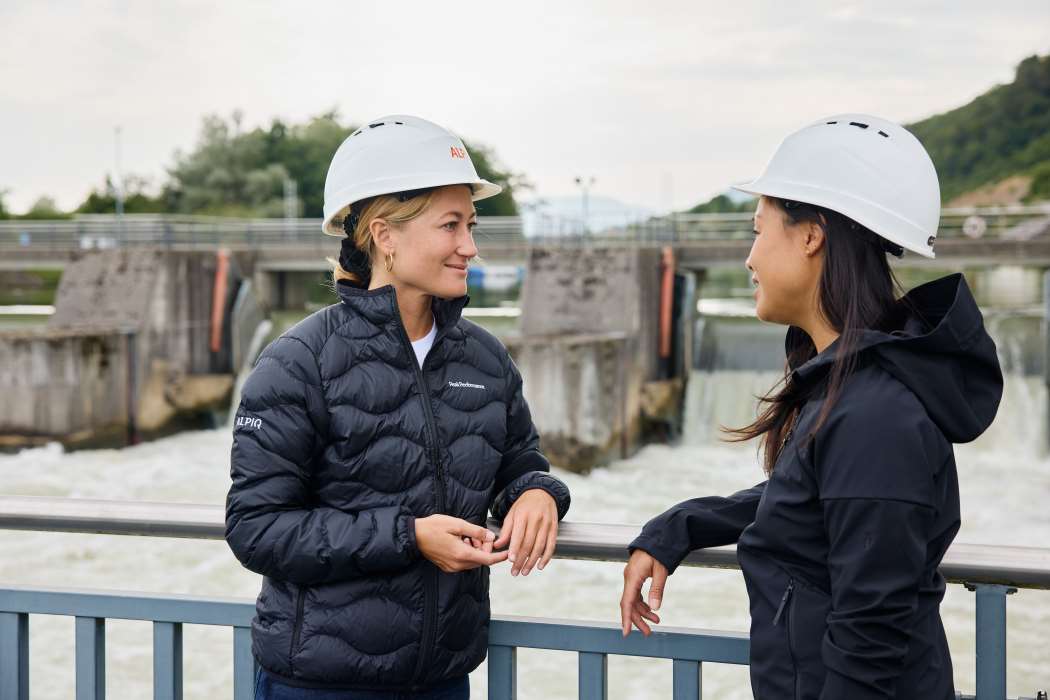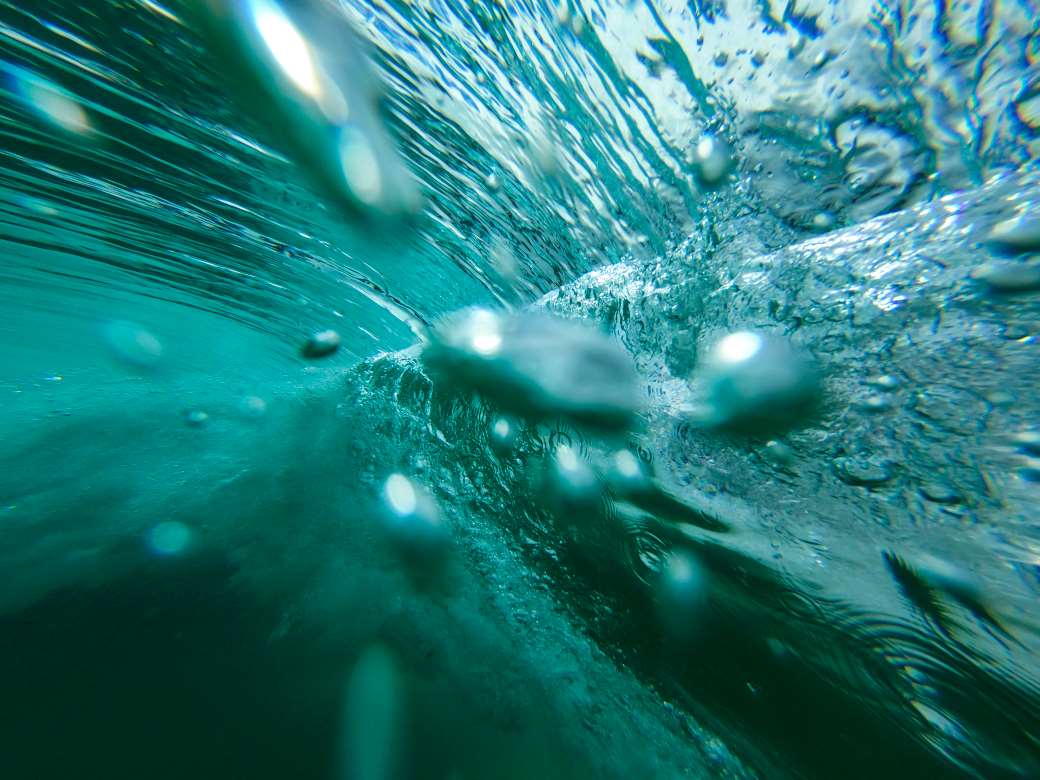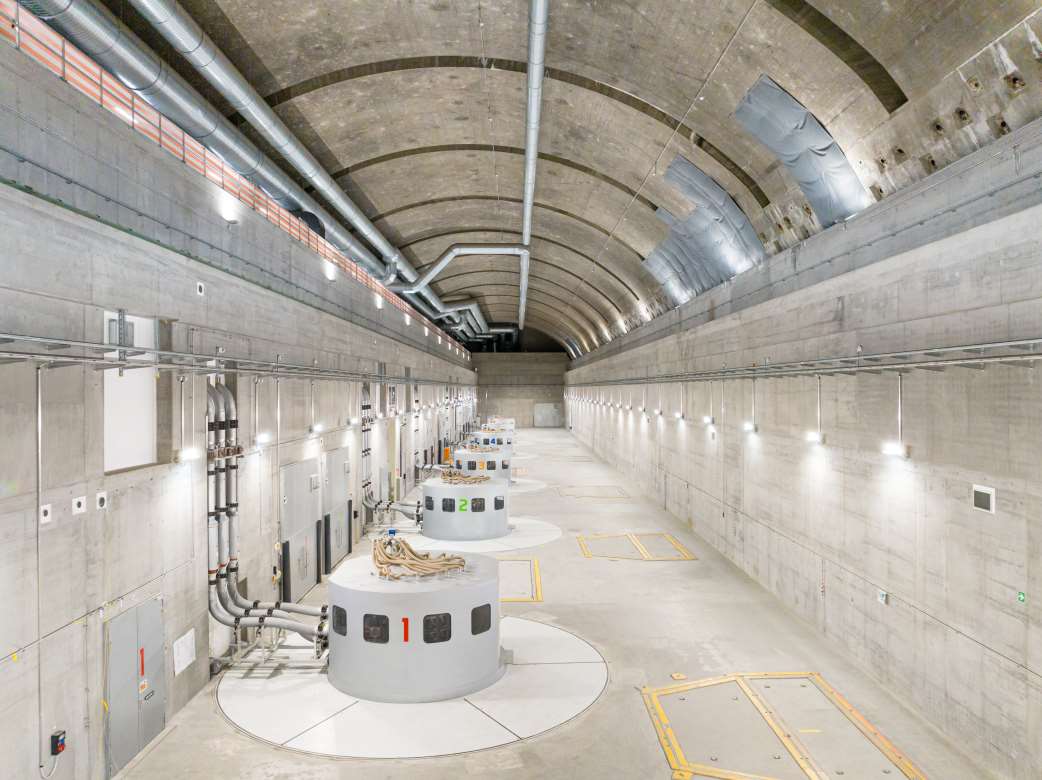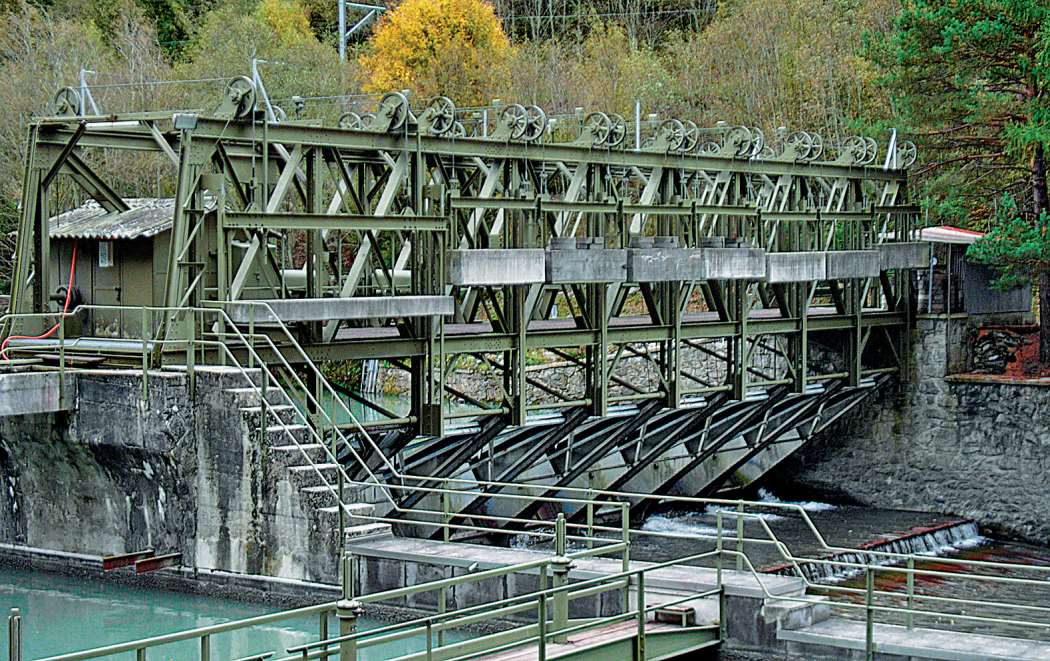Environmental dimension
Nurturing life on land and in water
Why is this important?
Alpiq owns and operates production facilities that have a significant footprint on the territory. The location of these facilities, particularly those using renewable energy, is strongly influenced by the natural resource (e.g. water, wind, solar) used, which leads to the construction of facilities in areas occupied by natural environments worthy of protection.
Alpiq’s activities therefore have an impact on biodiversity during the construction of new power plants, due to the use of natural areas, but also during operation, when the activity alters the conditions of the natural environment concerned. For example, hydroelectric facilities are often built in alpine areas and because of their functionality are located within valuable natural environments. They require a significant modification of the natural environments concerned, by modifying the hydrological regime of the watercourse, creating a significant vertical obstacle and a water reservoir.
The conditions of the aquatic fauna and flora are consequently often modified in a negative way, but sometimes these infrastructures also have a positive impact on the biodiversity, by creating a new lacustrine environment of high altitude, supporting the natural flows of the rivers during the periods of low water or supporting a new alluvial dynamic downstream.
What are we doing?
As a producer of renewable and low carbon energy, Alpiq is an important contributor in reducing the carbon footprint of the economy, tackling climate change and reducing the resulting impacts on fauna and flora.
We consider nature and biodiversity as important factors in each of our development projects and integrate them in their earliest stages. Alpiq collaborates with different interest groups and implements remediation, renaturation and compensation measures for its development projects and for the watercourses on which Alpiq operates. Alpiq complies with the mandatory environmental laws, goes beyond them whenever possible, and commits to having a long-term net positive impact on nature.
How do we track the effectiveness of our approach?
Alpiq manages its existing production sites as well as its development projects with a proactive approach, in order to minimize the impacts and promote the existing biodiversity. Environmental assessment, including nature and biodiversity, is a key part of all of our projects and plays an important role in driving our strategic choices, even at an early stage. Environmental knowledge is developed internally in the company, with teams specialized in this topic, which helps to improve the overall environmental quality of our projects.
Milestones in 2022
- ISO 14001 certification of Alpiq Suisse environmental management system
- FMMB received approval for project to modify residual deficit in the Trappist water intake
- Alpiq Eco Fund of Ruppoldingen to receive CHF 1.4 million of support for 16 projects
Numbers
- 1.4 – million (CHF) awarded in support of Ruppoldingen biodiversity projects
- 580 – metres along the Lantze Canal that have undergone renaturing.
- 517 – number of trout equipped with transmitters to assess functionality of Trappist fish pass
“Nowadays, it is important to develop projects in such a way that they fulfil the environmental requirements. In the past, the technical aspects were the main focus; the environment came second. Now we have to rethink our approach.”
Carlo Clivaz, Project Manager Generation Expansion, Alpiq Sion
Frameworks/guidelines
- Global Reporting Initiative standards
- ISO14001
- Environmental Management System (EMAS)
GRIs
- GRI 3-3: Management of material topics
Sustainable Development Goals
- SDG 15
Alpiq Eco Fund: More habitats to preserve biodiversity
Biodiversity in Switzerland is highly endangered. Accordingly, it is important to establish targeted measures to create, preserve or revitalize essential habitats for animals and plants. Since 2010, the Alpiq Eco Fund of the Ruppoldingen hydropower plant has financially supported well over 100 projects for environmental revaluation and improvement – mostly in the catchment area of the Aare power plant between Grenchen and Niedergösgen.

New wet biotopes or amphibian water habitats, the rehabilitation of ponds, restoration of shallow water zones, revitalisation of streams, new school modules as a contribution to environmental education, enhancement of river courses, maintenance of floodplain forests, mapping of spawning areas, etc.: The list of environmental improvement and revaluation measures that have been realized since 2010 thanks to financial assistance from the Alpiq Eco Fund of the Ruppoldingen hydropower plant is as long as it is diversified. It includes well over 100 projects. The projects have one thing in common: they contribute to the preservation of Switzerland’s severely threatened biodiversity. This is because they create and preserve precious habitats for a wide variety of animal and plant species or promote awareness of the importance of biodiversity.
The Ruppoldingen hydropower plant has been generating environmentally beneficial renewable energy on the Aare since 2000. Since 2010, the plant has been awarded the ‘naturemade star’ quality seal. The label is the top commendation for particularly eco-friendly energy produced from 100% renewable energy sources.
Power plants awarded the ‘naturemade star’ quality seal maintain a fund for environmental improvement measures. For every kilowatt-hour of electricity sold (guarantee of origin), 0.7 centimes (Rappen) are currently allocated to the fund. The money is earmarked and directly benefits nature and the environment. For example, the Alpiq Eco Fund of the Ruppoldingen hydropower plant has been used to support environmental revaluation measures worth almost 7 million Swiss francs since its inception.
#prixalpiq 2022: Rewarding awareness of the value of water
Each year, Alpiq, in partnership with the Association of Concession-Granting Municipalities of Valais, awards prizes worth a total of CHF 50,000 to support the municipalities of Valais in the development of concrete projects to boost sustainable water management. This year’s prize went to the “Regionale Wasserversorgung Südrampe” project for its innovative intercommunal system of governance to secure the regional supply of drinking water. A special prize was awarded to the film project “La Conquête de l’eau” by the municipality of Ayent.

The #prixalpiq, held by Alpiq together with the Association of Concession-Granting Municipalities of Valais, supports the municipalities of the Valais, Switzerland’s water reservoir, in their commitment to manage water efficiently, strive for sustainable solutions, and generate a tangible and positive impact.
The prize is awarded each year to a project carried out in collaboration with a Valais municipality that aims to preserve and optimize the use of water resources. Alpiq also undertakes to assist with the implementation of the winning project for one year and provides financial support.
Intercommunal governance to secure the regional supply of drinking water
Eight sustainable water management projects were submitted to the #prixalpiq jury in 2022. The jury selected the winning projects based on criteria such as sustainability, feasibility, the usefulness of the project for the municipalities and the level of innovation. The winning prize went to the municipalities of Visp, Naters, Brig-Glis and Lalden for their innovative “Regionale Wasserversorgung Südrampe” (Regional Water Supply of the Southern Ramp) project, which secures the drinking water supply of the agglomeration and meets the water needs of the municipalities and industry.
This innovative intercommunal collaboration enables the conveyance of spring water from the Munderberg to the distribution well in Visp in record time. Since spring 2022, more than a million cubic metres of water have been injected into the water supply of the municipalities in the agglomeration.
This project is an inspiring example of how to deal with the climate challenges of today and tomorrow, and stood out due to the innovative shared approach shown by the municipalities in managing resources. The next stage of the project, supported by the #prixalpiq award of CHF 40,000, is to extend this water supply system by constructing new pipes to guarantee access to drinking water until 2040.
A film raising awareness about the sustainable management of water resources
A special prize of CHF 10,000 was also awarded to the municipality of Avent for their film “La Conquête de l’Eau” (The Conquest of Water), which tells the story of the relentless struggle of our ancestors to find water in the Valais mountains.
The docudrama, featuring shots of spectacular alpine landscapes, brings home the importance of preserving water and the striking relevance of this topic today as society faces the challenges of climate change and periods of severe drought.
In recognition of their valuable contribution, the winning projects received a sculpture created with sand from the Rhône by a young Vaud artist enrolled at the école de design et haute école d’art of Valais, Laura Morier-Genoud.
Nant de Drance: Successful balance between hydropower production and nature
After more than ten years of successful collaboration, Nant de Drance SA, WWF and Pro Natura give a positive assessment of the environmental compensation measures planned for the Nant de Drance pumped storage power plant. Fifteen projects will help to balance the environmental impacts of the power plant and its connection to the European electricity grid.

Since the beginning of the Nant de Drance pumped storage power plant project, Nant de Drance SA, WWF and Pro Natura worked closely together to minimize the environmental impact of the power plant’s construction and its connection to the high-voltage grid. Through constructive dialogue, this exemplary collaboration between a hydroelectric company and environmental organisations has succeeded in finding the right balance between power production and nature conservation.
Biotopes to encourage recolonisation
Nant de Drance SA is implementing 15 environmental measures to offset its ecological impact, investing a total of CHF 22 million. WWF and Pro Natura are part of an advisory group which includes representatives from relevant public authorities, the canton of Valais and the Federal Office of Energy. This group discusses plans for the measures and monitors their implementation, with each participant putting forward their ideas to serve nature’s interests.
Most of the 15 measures aim to recreate specific biotopes locally, especially wetlands, in order to encourage recolonisation of the area by certain animal and plant species that are rare or endangered in Switzerland. In addition, Nant de Drance is carrying out this work with service providers across the region, in line with the legal framework relating to public procurements, and so that its investment can benefit the local economy. Water is the main focus of the compensation measures carried out by Nant de Drance SA. However, dry agricultural areas have not been forgotten. In Salvan, meadows and pastures have been reopened to enable people to use them and to stop them becoming wastelands.
Wetlands in the spotlight
The 15 environmental compensation projects are either currently underway, have already been completed or will soon be completed. For example, in Vernayaz, a 580-metre stretch of the Lantze Canal has undergone renaturing. The area provides fish fauna with favourable conditions in which to spawn. It can also provide them with a good habitat in general. Sedges, bulrushes and willowherbs, characteristic plant species of temporarily flooded environments, are already recolonising the newly created banks. In the immediate vicinity, the black alder forest of Fond du Mont is enjoying being in the water again and temporary ponds are already occupied by the yellow-bellied toad, a small toad rare in the Valais.
In Dorénaz, at the lower end of the Alesse stream, an aquatic environment has been recreated from two bodies of water. Since their water level varies according to the level of the nearby Rhône, part of the banks will sometimes be in water and sometimes dry. This should allow the fauna and flora typical of this type of environment to become established.
The 15 compensation measures are divided among the lowlands and mountains and, in addition to Vernayaz, Dorénaz and Salvan, mentioned above, have been or will soon be completed in the municipalities of Finhaut, Martigny, Saxon and Trient.
Martigny-Bourg: Water course optimized to support fish migration
Alpiq’s operation of the Martigny-Bourg power plant involves the intake of water from the Dranse river towards the power plant, where it is turbined. Studies showed that this was causing a residual deficit in the fish pass. In 2022, Forces Motrices de Martigny-Bourg SA, an Alpiq Group, developed a project to modify the intake of water through the installation of a new gate.

When the concessions for the Martigny-Bourg power plant were renewed in 2000, one of the compensation measures consisted in building a fish pass and ensuring its functionality. The fish pass was built in 2010. The evaluation of the effectiveness, carried out in several stages, led to the realisation of a monitoring of the fish migration by RFID (monitoring by radio frequencies of the crossing of the structure), by equipping 517 trout with transmitters, which confirmed the functionality of the fish pass for all size classes of river trout from 120 mm.
The Service de l’Energie et des Forces Hydrauliques (SEFH) and the Service de la Chasse, de la Pêche et de la Faune (SCPF) praised the quality of this monitoring and the results obtained.
Following these positive results, Forces Motrices de Martigny-Bourg SA (FMMB) was released from its obligations concerning the 2000 concession renewal. However, the study and the monitoring carried out revealed a residual deficit in the fish pass. Based on this observation, FMMB, in collaboration with the contractors biol conseils, Scimabio and Hydro Exploitation, have developed a project to modify the intake, requiring the installation of a new gate.
This new device, which will ensure a sufficient attraction flow on the left bank for fish fauna, will also facilitate dredging and reduce the risk of siltation in the area upstream of the fish pass. FMMB received the approval for this modification project in July 2022. The work on the modification of the structure will be undertaken once the last administrative steps of financing have been arranged with the Federal Office for the Environment (FOEN).